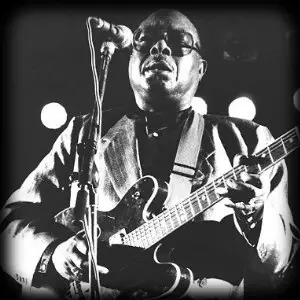JIMMY ROGERS
 Muddy Waters‘ searing slide-guitar work is seen as the cornerstone of Chicago’s electric Blues tradition, but the precise and sympathetic chord patterns of Jimmy Rogers’ ‘second’ guitar features on all the great Chess recordings too. As Muddy’s right-hand man; as part of the Chess house-band; and as a singer and bandleader in his own right, Jimmy made a huge contribution to the ‘Golden Age’ of Chicago Blues. He was also generous in passing on his expertise to new generations of modern Blues players.
Muddy Waters‘ searing slide-guitar work is seen as the cornerstone of Chicago’s electric Blues tradition, but the precise and sympathetic chord patterns of Jimmy Rogers’ ‘second’ guitar features on all the great Chess recordings too. As Muddy’s right-hand man; as part of the Chess house-band; and as a singer and bandleader in his own right, Jimmy made a huge contribution to the ‘Golden Age’ of Chicago Blues. He was also generous in passing on his expertise to new generations of modern Blues players.
‘Where’s My Woman Been’, from September 1949;
Jimmy was an important member of the Chess house-band, and was Muddy’s indispensable ‘second’ guitar for many years, but he also maintained his solo career. His 1950 debut for the Chess label, ‘That’s All Right’, became a standard, and others like ‘Back Door Friend’, ‘Sloppy Drunk’ and ‘Chicago Bound’ encouraged Jimmy to leave Muddy and front his own band. He also found plenty of work as a session musician, playing on T-Bone Walker‘s ‘Why Not?’ and borrowing the tune for his own ‘Walkin’ By Myself’ which did well in the R&B charts. This record has a blistering harp solo that made the reputation of ‘Big Walter’ a.k.a. ‘Shakey’ Horton, who was a last minute stand-in for the ‘studio-shy’ Good Rockin’ Charles. By the end of the 50s, even high-quality up-tempo Blues records like Jimmy’s ‘Rock This House’ were not selling in big numbers, so Jimmy retired from music to raise a family and start a clothing business.
Jimmy and ‘Shakey’ perform ‘Golden Tailed Bird’;
After ten years away from the studio, Jimmy cut the fantastic ‘Golden Tailed Bird’ album for Leon Russell’s Shelter label in 1972, with contributions from Freddie King and legendary Chicago backing band The Aces. He followed it up with ‘Sloppy Drunk’, which had Willie Mabon on piano, and played on several American Blues Festival tours of Europe in the 70s, adding to his reputation as a singer rather than ‘just’ Muddy’s side-kick. A new generation of Blues stars worked with Jimmy in the 80s, notably harp players Rod Piazza, Carey Bell and Kim Wilson, and with guitarist Ronnie Earl and Chuck Berry‘s pianist Johnnie Johnson in the 90s. Jimmy’s ‘swan-song’ came with his 1998 album ‘Blues, Blues, Blues’ with Jagger/Richards, Page/Plant, Clapton, Taj Mahal, Jeff Healey and many more who wanted to pay homage to a Bluesman who made an indelible mark on the music. Sadly, it was to be a posthumous release, as Jimmy passed away just before Xmas 1997.